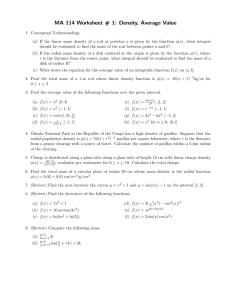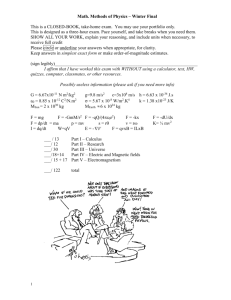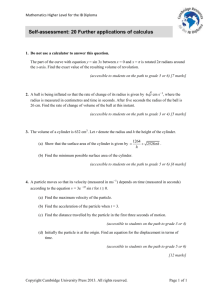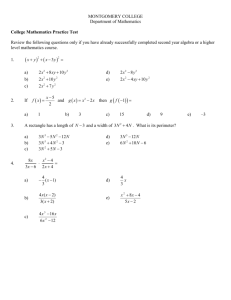WinFinalSoln
advertisement
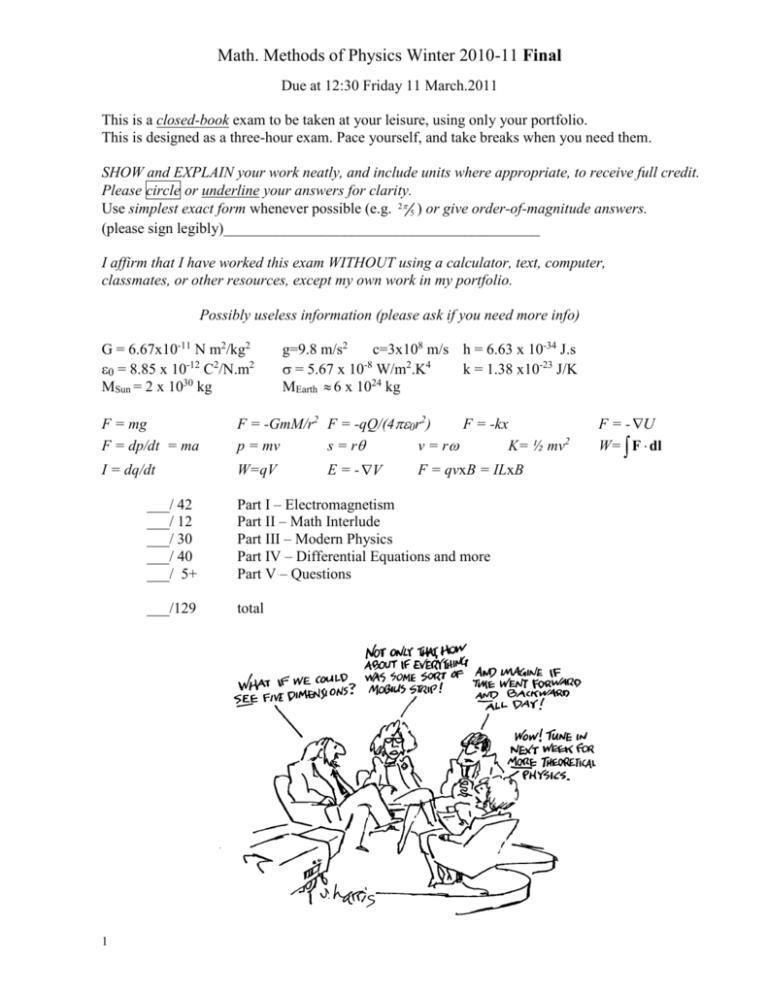
Math. Methods of Physics Winter 2010-11 Final Due at 12:30 Friday 11 March.2011 This is a closed-book exam to be taken at your leisure, using only your portfolio. This is designed as a three-hour exam. Pace yourself, and take breaks when you need them. SHOW and EXPLAIN your work neatly, and include units where appropriate, to receive full credit. Please circle or underline your answers for clarity. Use simplest exact form whenever possible (e.g. 2 5 ) or give order-of-magnitude answers. (please sign legibly)__________________________________________ I affirm that I have worked this exam WITHOUT using a calculator, text, computer, classmates, or other resources, except my own work in my portfolio. Possibly useless information (please ask if you need more info) G = 6.67x10-11 N m2/kg2 0 = 8.85 x 10-12 C2/N.m2 MSun = 2 x 1030 kg g=9.8 m/s2 c=3x108 m/s h = 6.63 x 10-34 J.s = 5.67 x 10-8 W/m2.K4 k = 1.38 x10-23 J/K 24 MEarth 6 x 10 kg F = mg F = dp/dt = ma F = -GmM/r2 F = -qQ/(40r2) F = -kx p = mv s = r v = r K= ½ mv2 I = dq/dt W=qV 1 E = - V F = qvxB = ILxB ___/ 42 ___/ 12 ___/ 30 ___/ 40 ___/ 5+ Part I – Electromagnetism Part II – Math Interlude Part III – Modern Physics Part IV – Differential Equations and more Part V – Questions ___/129 total F = - U W= F dl Part I. Electromagnetism (about 1 hour) 1. Check all the fields that could possibly be present, for each charge motion. E alone B alone ✓ v || B a. Charge at rest b. Charge moving at a constant speed c. Charge accelerating in a straight line E and B together ✓ d. Charge bending at constant speed vEB v || B vB e. Charge bending and accelerating ✓ 2. Describe how potentials V are related to electric fields E, (a) qualitatively and (b) quantitatively V rˆ r V E dr E V Electric field lines and equipotential lines are mutually perpendicular. 3. Is an electric field stronger where equipotentials are concentrated or spread out? Explain. E V : Stronger E at stronger GRADIENTs in V 4. Is an electric field stronger near a pointy conductor or a smooth one? Explain. Dotted lines are equipotentials (parallel to the solid equipotential surface. Solid field lines are perpendicular. 5. Is it safer to stand up or crouch down in a lightening storm? Explain. Lightning is attracted to strong gradients in V, which collect at points. Get low and round. (10) 2 6. Draw the direction of the magnetic force for each situation below. Assume positive charges. (6) F=0 . 7. A device measures the mass of charged particles by first determining their velocity and then deflecting them with a magnetic field. (a) Velocity selector: When a charged particle travels through crossed E and B fields (both of which fill the region below), the trajectory will be undeflected (continuing in a straight line) only if the velocity has a certain relationship to E and B. This setup effectively “selects” particles with velocity v. uniform B x x x x x x x x x x x x x x x x F qE qv B when x x x x qE qv B or E vB uniform E (a) Derive the relationship between E, v, and B (b) that will select undeflected particles of velocity v. E vB with v perpendicular to both E and B, e.g. going from left to right. 7 (b) If the electric field E doubles, how will the selected particle’s ENERGY change? It will: (show your work) Halve - stay the same – double – quadruple – other Since v~E and KE = 12 mv 2 , therefore KE ~ E2 and the energy quadruples. (Assuming nonrelativistic.) Now that we know the speed v of the particle from the E and B settings, we’d like to determine the mass m of the particle – which is the point of this device. (5) 3 (7) Magnetic deflection: When a charged particle of velocity v enters a region of perpendicular magnetic field (B) (where E=0 now), how is it deflected? (c) Sketch the path of a positively charged particle. (d) Derive an expression for its radius of curvature in terms of q, v, m, and B. (e) Find the mass of the particle in terms of measurable quantities (r, E, and B) and the charge q. F ma uniform B v x x x x x x x x x x x x x x x x x x x x v2 r mv r qB qvB m m rqB rqB rqB 2 E v E B (Assuming that B is the same in both regions – otherwise, it would be m rqB1B2 .) E (f) If the magnetic field B in the deflection region doubles, how will the RADIUS of curvature of the particle’s path change? (Assume fields in the velocity selection region are unchanged.) It will: (show your work) Halve - stay the same – double – quadruple - other Since r~1/B in the deflection region, if the field doubles, the radius of curvature ~ ½: r k B k r2 B2 B1 k r1 B2 B1 B2 2 B1 r2 1 r1 2 (6) 4 8. (a) Find the charge distribution q(r) inside a sphere which carries a charge density proportional to the distance from the origin, = c r, for some constant c. [Hint: A spherical volume element is d= r2 sin dr d d where (0<<) and (0<).] (b) Sketch q(r) and (r). (c) Find the electric field inside the sphere. (d) What is the total charge Q in the sphere? Express the electric field outside the sphere in terms of Q. (e) How could you find the energy in this charge configuration? You need not calculate it, but set it up. (10) 5 9. A metal sphere of radius R, carrying charge q, is surrounded by a thick concentric metal shell with inner radius a and outer radius b, as drawn below. The outer shell carries no net charge. (a) Find the surface charge density at R, at a, and at b. (b) Find the electric field E everywhere. (c) If the outer shell is touched to a grounding wire, how do your answers change? Why? (d) Find the capacitance of the system. (15) 6 Part II - Math interlude (12) 1. Is each function below a vector or a scalar? (a) v = x sin y xˆ + cos y yˆ + x y zˆ VECTOR (b) T e5 x sin 4 y cos3z SCALAR 2. What is the definition of the function del or (in Cartesian coordinates)? xˆ yˆ zˆ (del is a vector operator) x y z 3. (a) Can one find the Laplacian ( 2 ) of a scalar or vector function? (b) Find the Laplacian of the appropriate function from (1) above. 2T 2T 2T 2T x 2 y 2 z 2 T T T 5e 5 x sin 4 y cos3 z, 4e 5 x cos 4 y cos3 z, 3e 5 x sin 4 y sin 3 z x y z 2T 2T 2T 5 x 5 x 25 e sin 4 y cos3 z , 16 e sin 4 y cos3 z , 9e 5 x sin 4 y cos3 z 2 2 2 x y z 2T 2T 2T 25 T , 16 T , 9T x 2 y 2 z 2 2T 25T 16T 9T 0 4. (a) Can one find the divergence and curl of a scalar or vector function? (b, c) Find the divergence and curl of the appropriate function from (1) above. v Divergence: x sin y cos y x y x y z sin y sin y 0 0 xˆ yˆ zˆ v x y z x sin y cos y xy Curl: xˆ xy cos y yˆ xy x sin y zˆ cos y x sin y z z y x y x xˆ x 0 yˆ y 0 zˆ 0 x cos y v x xˆ y yˆ x cos y zˆ 7 Part III: Modern physics (less than an hour) 1. If an electron in the Bohr orbit n = 4 transitions to n = 2: (a) Find the energy difference between the orbits. (b) Find the emitted wavelength. (c) Is this in the visible range? We derived in class that En=E0/n2, where E0= -13.6 eV is the ground state (n=1). 1 4 3 1 1 (a) E E0 2 2 13.6eV 13.6eV 2 4 16 16 16 hc (b) The emitted wavelength can be found from E : hc 1240 eV .nm 400 *16 nm 500 nm E 3*13.6eV / 16 13.6 (c) Yes, this is visible – probably orange or yellow, since red is over 600 nm. 2. If an electron is in the “3p” state: (a) What do you know about its energy quantum number, n? n=3 (b) What do you know about its angular momentum quantum number, ? =1 (c) What do you know about the orientation of its angular momentum, m? nothing specific in this case, but it could take values of 0, -1, or 1. (d) What do you know about its spin quantum number, ms? An electron has spin= ± ½ (e) Diagram, and list the excited states (in spectroscopic notation) to which the 3p state can make downward transition (ignoring forbidden transitions to which it may tunnel). Transitions must have 1 , so p (=1) could go to s (=0) or d (=2) state. There are two s states that fit the fill: n=2 and n=1 both have (=0) states. However, d (=2) does not have an n=2 state, (<n), therefore p cannot make a downward transition to d (=2). (f) How would the spectrum change in the presence of an external magnetic field? m splittings would arise, permitting fine-structure transitions (due to spin-orbit coupling) (15) 8 3. If the angular momentum of the Earth in its motion around the Sun were quantized like a nh hydrogen atom according to L mvr n , 2 (a) What would Earth’s quantum number be? (b) How much energy would be released in a transition to the next lowest level? (c) Would that energy release (presumably in a gravity wave) be detectable? (d) What would be the radius of that orbit? (The radius of Earth’s orbit is 1.5 x 1011 m.) (15) 9 Part IV: Differential Equations and more (1 hour or so) y 2 x2 1. Solve y ' . 2 yx (Hint: Bernoulli eqn: Let z y n 1 …) (10) 2. Lagrange multipliers: Consider a particle of mass m in a 3D quantum mechanical well. The well is a rectangular box with sides a, b, and c. The ground state energy of the particle is given h2 1 1 1 by E (10) 2 2 2. 8m a b c (a) Find the shape of the box (a, b, and c) that will minimize the energy E, subject to the constraint that the volume is constant. (b) Find the minimum energy. 10 0, x 0 3. (a) Sketch the PERIODIC function f ( x) . x, 0 x (b) Is it even, odd, or neither? (10) (c) Does it make more sense to expand f(x) in a cos/sin or exponential Fourier series? Why? (d) Expand f(x) in the most economical Fourier series. [Hint: 4. Solve D 2 4 y 16cos 4 x : (a) (b) (c) (d) (e) (f) 11 xe inx 1 ix dx e inx 2 .] n n (10) Write the differential equation in terms of derivatives of y. Solve for the roots of the characteristic (or homogeneous) equation. Write the characteristic (or homogeneous) solution, yc, with undetermined coefficients. Write a particular solution yp, based on the nonhomogeneous part of the equation. Check for constraints on undetermined coefficients. Write the general solution to the equation. How do you feel about your work and your learning so far? What question(s) do you wish had been on this exam? Feedback or questions for your prof? 12 (5) (extra)


